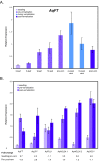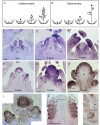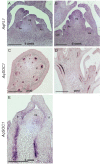Environmental and molecular analysis of the floral transition in the lower eudicot Aquilegia formosa
- PMID: 21329499
- PMCID: PMC3049749
- DOI: 10.1186/2041-9139-2-4
Environmental and molecular analysis of the floral transition in the lower eudicot Aquilegia formosa
Abstract
Background: Flowering is a critical transition in plant development, the timing of which can have considerable fitness consequences. Until recently, research into the genetic control of flowering time and its associated developmental changes was focused on core eudicots (for example, Arabidopsis) or monocots (for example, Oryza). Here we examine the flowering response of Aquilegia formosa, a member of the eudicot order Ranunculales that is emerging as an important model for the investigation of plant ecology and evolution.
Results: We have determined that A. formosa has a strong vernalization requirement but little or no photoperiod response, making it a day neutral (DN) plant. Consistent with this, the Aquilegia homolog of FLOWERING LOCUS T (AqFT) is expressed in both long and short days but surprisingly, the locus is expressed before the transition to flowering. In situ hybridizations with homologs of several Arabidopsis Floral Pathway Integrators (FPIs) do not suggest conserved functions relative to Arabidopsis, the potential exceptions being AqLFY and AqAGL24.2.
Conclusions: In Aquilegia, vernalization is critical to flowering but this signal is not strictly required for the transcriptional activation of AqFT. The expression patterns of AqLFY and AqAGL24.2 suggest a hypothesis for the development of Aquilegia's determinate inflorescence whereby their differential expression controls the progression of each meristem from inflorescence to floral identity. Interestingly, none of the Aquilegia expression patterns are consistent with a function in floral repression which, combined with the lack of a FLC homolog, means that new candidate genes must be identified for the control of vernalization response in Aquilegia.
Figures






References
-
- De Bodt S, Maere S, Van de Peer Y. Genome duplication and the origin of angiosperms. Trends in Ecology & Evolution. 2005;20:591–597. - PubMed
LinkOut - more resources
Full Text Sources

